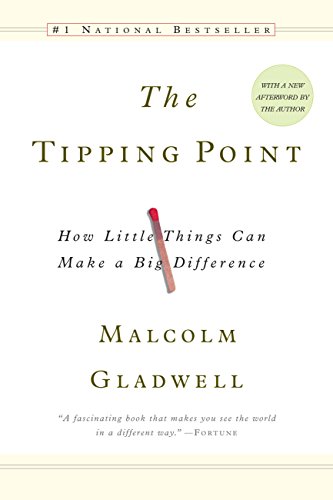

This article is an excerpt from the Shortform summary of "The Tipping Point" by Malcolm Gladwell. Shortform has the world's best summaries of books you should be reading.
Like this article? Sign up for a free trial here .
What are the keys to creating a great, “sticky” marketing message? How do you get your marketing messages to spread?
We’ll look at how to formulate marketing messages that stick and how to spread them to create an epidemic.
What Makes a Great Marketing Message?
Ideas, marketing messages, behaviors, and products can spread through a population in a social epidemic in the same way that viruses spread. Epidemics have a few common characteristics.
- Epidemics are contagious. Whether a virus or an idea, it passes quickly and easily from person to person.
- Small changes have big impacts. In the case of a flu going around the office, a change in the strain of the virus could make it last longer, which creates a bigger window of time that people are sick and can spread the germs. Or, something as small as running out of tissues or hand sanitizer in the conference rooms could make a significant difference in the virus’ spread.
- Epidemics don’t build gradually and steadily; they grow and reach a boiling point or critical mass, at which point they explode and turn into an epidemic. That threshold is called the tipping point.
There are three factors that can be adjusted to turn a marketing message into a social epidemic: the messenger, the marketing message itself, or the context of the marketing message.
- The Law of the Few: Certain types of people are especially effective at spreading an infectious idea, product, behavior, or marketing message.
- The Stickiness Factor: You can change the presentation of a marketing message to make it more contagious and stickier (having a more lasting impact).
- The Power of Context: The environment in which the marketing message or idea is delivered can have a huge impact on whether enough people adopt and spread it to create an epidemic.
Employing one, two, or all three of these principles can tip an epidemic.
Use the Right Messengers (The Law of the Few)
When you’re trying to spread a marketing message, idea, or product to epidemic proportions, you can’t do it all yourself; you need people to help preach your message and spread the word to the masses. But not just anyone will do. The Law of the Few proposes that there are certain, special types of people who are much more effective at broadcasting your idea and getting people to listen and follow suit in order to create an epidemic.
These special people fall into three personality types that make them exceptional either in their social connections, knowledge, or persuasiveness.
The Law of the Few is a more extreme version of the 80/20 Principle in economics, which dictates that in a given situation, about 20 percent of participants will be responsible for 80 percent of the “work.” For example, 20 percent of drivers cause 80 percent of all traffic accidents. And in many societies, 20 percent of criminals are responsible for 80 percent of crimes.
Make Your Idea Stick (The Stickiness Factor)
Epidemics tip not only because of the behavior of a handful of key players. A change in the contagiousness and strength of the virus, marketing message, or idea itself can also cause it to tip.
In medical terms, this is when a virus evolves to become more contagious or more infectious. When that happens, people who are infected are less able to fight it off, or stay sick longer, creating more opportunity to infect more people.
- A Dutch AIDS researcher named Jaap Goudsmit traced what he believed to be one of the earliest HIV epidemics to a Dutch hospital ward dedicated to caring for underweight and premature infants. Over the course of three years in the 1950s, 81 infants came down with a form of pneumonia that is closely associated with HIV (which depletes people’s ability to otherwise fight off the illness). Only 24 of the sick infants died, indicating that the HIV virus was less deadly than the form that infected and killed so many people in the 1980s. The virus itself morphed to become more virulent, making it more effective in creating an epidemic.
In social epidemics, this is the factor that makes a marketing message stick or make an impact. In a marketing context, stickiness makes an ad stand out from the white noise of all the media we encounter. (Shortform example: Think of advertisements from 20 or more years ago that still stand out in your head. Maybe it’s the Budweiser “Whassup?” commercial, or (stretching back almost 50 years) the “Mikey Likes It” Life cereal ads.)
To understand the importance of the Stickiness Factor, consider this: If you don’t remember the marketing message, what are the chances you will change your behavior or buy the product? Making an idea sticky and impactful is often a matter of surprisingly small, subtle changes.
Change How the Marketing Message is Received (The Power of Context)
Human behavior is greatly affected by the context of our environments. The Power of Context capitalizes on this insight and suggests altering the context in which people receive your marketing message or idea can make them more receptive to it. This is a little abstract, so let’s take a look at some examples.
On a small scale, you probably behave differently whether you’re with your family, your coworkers, or your old college friends. You’re also likely to act differently in public than you do in the privacy of your home. Is this effect powerful enough to determine whether you follow a fashion trend or join a social movement?
We often don’t realize how profoundly the environment alters how we act. Context changes subconsciously cue us to behave differently — sometimes drastically so — or force us into a new routine that has ripple effects on our actions.
- (Shortform example: Say you take the same route to work every day. One day, the bridge you cross is closed for a construction project that will last three months. You are forced to take another route. This, in and of itself, is a change in behavior. But perhaps this new route is also 15 minutes longer, so you have to set your alarm earlier, or shorten your morning workout, or miss your favorite morning news segment because it comes on at 7:20 and now you have to be out of the house at 7:15. A small change can have many downstream ripple effects.)
Even subtle changes can have a significant effect on how we act. In 1964, a woman named Kitty Genovese was stabbed and killed on a NYC street, despite the fact that there were 38 people witnessing the attack. At the time, most reports of the incident blamed witnesses’ inaction on urban callousness. Psychologists later attributed this to the “bystander effect,” which says that when people are in a group, they are less likely to act because they either assume someone else will or assume the problem is less serious because other people are not acting. Genovese, then, would have had a better chance of getting help if she’d been attacked in a more discreet location with just one witness. However, most reports of the incident blamed witnesses’ inaction on urban callousness.
———End of Preview———

Like what you just read? Read the rest of the world's best summary of "The Tipping Point" at Shortform . Learn the book's critical concepts in 20 minutes or less .
Here's what you'll find in our full Tipping Point summary :
- What makes some movements tip into social epidemics
- The 3 key types of people you need on your side
- How to cause tipping points in business and life






